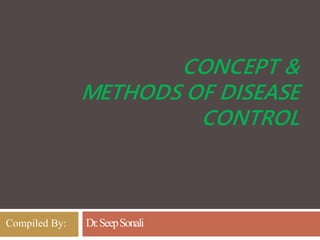
Disease control.pptx
- 1. CONCEPT & METHODS OF DISEASE CONTROL Dr.SeepSonali Compiled By:
- 2. Disease Control The term ‘disease control’ describes operations aimed at reducing: I. The incidence of disease II. The duration of disease, and consequently the risk of transmission III. The effects of infection, including both the physical and psychosocial complications; and IV. The financial burden to the family and community
- 4. Diseasecontrolincludes. . . Control Elimination Eradication Extinction public policy intervention that restricts the circulation of an infectious agent beyond the level that would result from spontaneous, individual behaviors to protect against infection Reduction to zero of the incidence of a specified disease in a defined geographical area as a result of deliberate efforts Termination of all transmission of infections by extermination of infectious agents The specific infectious agent no longer exists in nature or in the laboratory
- 5. Disease Elimination This term is used to describe the cessation of transmission of disease in a single country, continent, or other limited geographic area, rather than global eradication (e.g., polio in the Americas). It is an intermediate goal between control and eradication
- 6. Disease Eradication • It literally means “tear out by roots” • Eradication of diseases implies termination of all transmission of infection by extermination of the infectious agent. • It is an absolute process; an “all or none phenomenon” • Small pox is the only disease that has been eradicated (eradicated by 1980)
- 7. Frameworkforeradication Scientific considerations Operational considerations Economic considerations
- 8. Framework for eradication Scientific considerations Geographic and environmental controls Potential reservoirs Transmissibility Natural resistance to reinfection Laboratory containment Operational considerations Economic considerations
- 10. Framework for eradication Scientific considerations Operational considerations Economic considerations Private vs Social net benefit Short term vs long term benefits Local vs international benefits
- 11. Surveillance The term “surveillance” is derived from the French word meaning “to watch over” In 1968 the 21st World Health Assembly described surveillance as the “systematic collection and use of epidemiologic information for the planning, implementation, and assessment of disease control”; in this sense, surveillance implies “information for action”.
- 12. Surveillance is a continuous process which involvesthree primary activities: i. Collection of relevant data for a specified population, time period and/or geographic area; ii. Meaningful analysis of data; iii. Routine dissemination of data with accompanying interpretation. surveillance.. .
- 13. Objectives of Surveillance I. It is a tool to estimate the health status of populations by using morbidity, mortality, nutritional indicators, etc. II. It is useful both for measuring the need for interventions and for directly measuring the effects of interventions III. Provide feed-back to modify the policy and system and redefinition of objectives IV. Timely warning of public health disasters so that interventions can be mobilized.
- 14. Dutiesofhealthcareprofessionalsinsurveillance Identify and describe each individual having an infectionas quickly as possible after exposure. Determine the source ofinfection. Identify exposed individuals to whom the infection may have been transmitted. Specify the frequency of occurrence of infection in population groups at risk by person, place and time. Identify populations that are experiencing, or might experience, an increased frequency ofinfection. Prepare and distribute surveillance reports to health care professionals participating in disease prevention and control activities.
- 15. Typesofsurveillance Passive surveillance: receipt of reports of infections/disease from physicians, laboratories and other health care professionals required to submitsuch reports as defined by public health legislation Active surveillance: Active disease surveillance is also based on public health legislation and refers to daily, weekly or monthly contacting of physicians, hospitals, laboratories, schools or others to “actively” search for cases Usually seasonal or done during disease outbreaks
- 16. Monitoring •It is the performance and analysis of routine measurements aimed at detecting changes in the environment or health status of population. •Monitoring is a part and parcel of surveillance •It keeps track of goal achievement, resource utilization and availability
- 17. Evaluation •It is used to assess how well a programme is performing •Actual results are compared with the intended objectives •Evaluation may be crucial in identifying the health benefits derived (impact on morbidity, mortality, patient satisfaction, etc.)